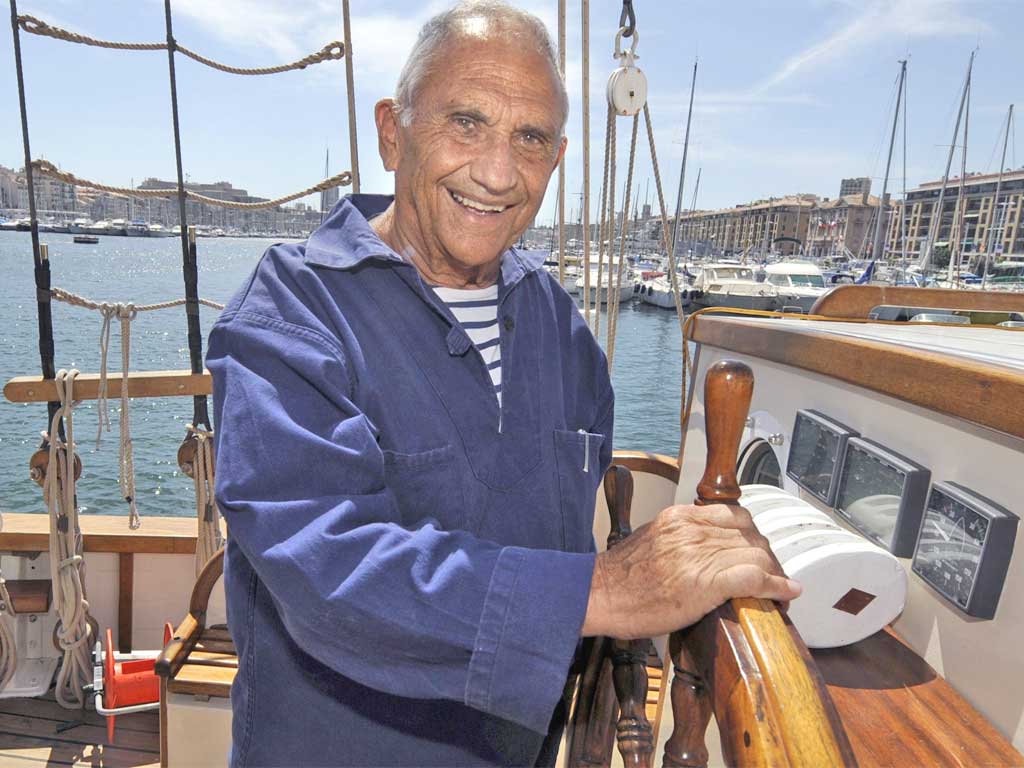Albert Falco: Diver who worked with Jacques Cousteau

The underwater films of the late Jacques Cousteau enchanted and entranced several generations of cinema-goers and TV viewers throughout the 1950s, '60s and '70s and played an important part in raising environmental awareness. The diver, Albert Falco, was Cousteau's right-hand man for 37 years and helped make the Oscar-winning documentaries The Silent World in 1956 and World Without Sun in 1964, as well as the celebrated television series The Undersea World Of Jacques Cousteau.
Known as Bébert to his colleagues, the stocky Falco always wore a marinière, the traditional white and blue sailor's shirt, and cut a distinctive figure alongside Cousteau as they circumvented the globe a dozen times. He started out as a deckhand but eventually captained the Calypso, the former Royal Navy minesweeper converted into a research vessel by the explorer and film-maker. "Cousteau wanted people to understand the ocean so they would learn to love and protect its diversity," Falco said.
Born in 1927, he was a fearless child, happy to follow his parents and dive into the turquoise waters of the Calanque de Sormiou, one of the picturesque coastal inlets between Marseilles and Cassis. His father had served in the French Navy and taught him to fish with a spear-gun. Later, he met the inventor Georges Beuchat, another keen diver who designed underwater equipment and sold wetsuits and swimfins at his store on the Vieux Port. "He lent me his goggles and opened the blue door of the deep," recalled Falco, who joined the Groupement De Pêche Et D'Etudes Sous-marines, the local diving and underwater survey team established in Marseilles in 1941.
He became an experienced scuba diver with a great amount of local knowledge. In 1950, he tried out the Aqua-Lung autonomous diving suit pioneered by Emile Gagnan and Cousteau, who he met two years later: "Cousteau and his friends were accepting volunteers, weekend divers, to help explore a very ancient shipwreck off the coast of Marseilles. I joined the team. The dream became a reality."
The Grand-Congloué wreck turned out to be a baffling combination of two superimposed ships – one 2nd century BC, the other 1st century BC. The rudimentary techniques the divers used to bring amphorae to the surface meant that a third fell apart, but closer analysis revealed that they came from as far away as Greece and what is now Tuscany. The cargo is on display at the Museum of the Roman Docks at Marseilles.
Falco took to his ever-changing roles with gusto. In 1954, he participated in a lengthy expedition to the Red Sea and the Indian Ocean which provided much of the footage for The Silent World. In 1959, he was the first to pilot a circular "diving saucer" designed by Cousteau and Jean Mollard which could reach a depth of 350 metres. Twice he spent a week living in an underwater house, Diogene in the Mediterranean, then Conshelf 2 in the Red Sea, as documented in World Without Sun in 1964. "If I was going to die, it might as well be for the benefit of science," he said.
He had several narrow escapes, usually involving sharks – "my best friends". Most famously, during one excursion the surface team sent down a half-filled airtank for him and Claude Wesly. They made it back to the relative safety of Conshelf 2, but it was a close call.
Cousteau's early documentaries featured interaction between the crew and underwater creatures, sometimes with disastrous consequences for the animals, and occasionally make for uncomfortable viewing four or five decades on. However, Cousteau, Falco and the team adopted a more benign outlook and helped change attitudes towards the ocean and marine life. "The sea needs to be protected," Falco said. "The real danger is man, we're the sharks."
In 1977 Cousteau and Falco surveyed the effects of pollution in the Mediterranean and demonstrated the impact of detergents and untreated sewage. Falco subsequently accompanied Gaston Defferre, the Marseilles mayor, on a dive which led to the installation of a much-neaded treatment plant.
Falco retired in 1990 but still made environmental and educational films. He also campaigned for the creation of marine reserves in Martinique and in Provence. A few days before his death, he learned that a decree creating the Parc National des Calanques, a protected land and maritime zone covering more than 50,000 hectares near Marseilles, had passed into French law.
He was appointed Chevalier de la Légion d'Honneur and had recently published his life story. Falco only had one regret: that the Calypso, which sank in 1996 after being rammed by a barge in the port of Singapore, and was then raised and brought back to France, still languishes in a Concarneau shipyard. The theme music from The Undersea World Of Jacques Cousteau was played at Falco's funeral while the flag of the Calypso was draped around his coffin. "In order to be happy, one must have a passion in life," he once said. "Mine was the sea, from a vary young age."
Pierre Perrone
Albert Falco, diver and environmental campaigner: born Marseilles 17 October 1927; married (one daughter); died Marseilles 21 April 2012.
Join our commenting forum
Join thought-provoking conversations, follow other Independent readers and see their replies
Comments
Bookmark popover
Removed from bookmarks